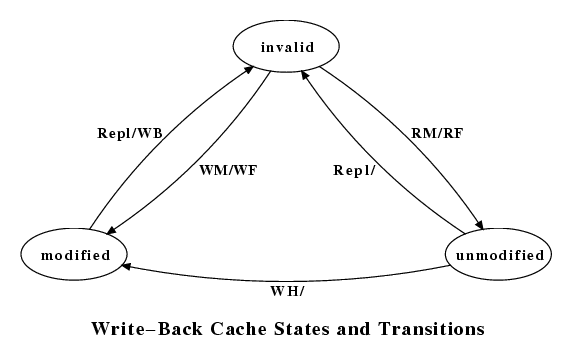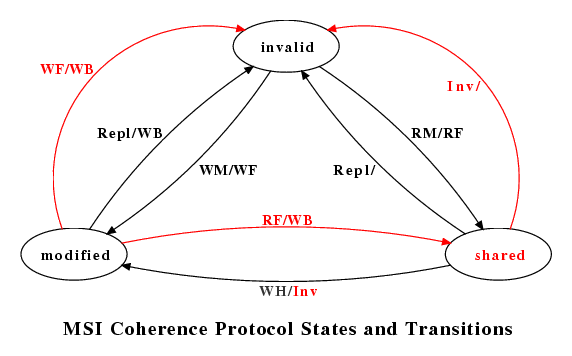For higher performance in a multiprocessor system, each processor will
usually have its own cache.
Cache coherence refers to the problem of keeping the data in
these caches consistent.
The main problem is dealing with writes by a processor.
There are two general strategies for dealing with writes to a cache:
-
Write-through - all data written to the cache is also written to
memory at the same time.
-
Write-back - when data is written to a cache, a dirty bit is
set for the affected block.
The modified block is written to memory only when the block is
replaced.
Write-through caches are simpler, and they automatically deal with the
cache coherence problem, but they increase bus traffic significantly.
Write-back caches are more common where higher performance is desired.
The MSI cache coherence protocol is one of the simpler write-back
protocols.
Write-Back Cache States Diagram

A write-back cache can be described by the diagram to the right,
which shows the states and transitions for a block in the cache.
The transition labels have the form
"event/action".
The event can be viewed as the trigger for the transition.
The only actions mention here are bus actions.
Transitions from a state to itself with no bus actions are omitted.
The following abbreviations are used for events:
-
RH - read hit
-
WH - write hit
-
RM - read miss
-
WM - write miss
-
Repl - replacement
The following abbreviations are used for bus actions:
-
RF - read fetch
-
WF - write fetch
-
WB - write back
Development of a new idea is easier if you can make an incremental
change from a well-established idea.
This involves adapting the older idea to new requirements.
The development is easier if you have heuristic principles that
keep you away from excessive complexity.
For developing a multiprocessor write-back cache here are two
useful principles:
-
Each cache only keeps track of the blocks that it holds;
all other blocks are in the invalid state.
-
Maintain an invariant: if a cache holds a block in the modified
state then all other caches must have that block in the invalid
state.
In order to maintain the invariant, each cache must snoop
on the bus - it must listen to bus transactions that are performed by
other caches.

